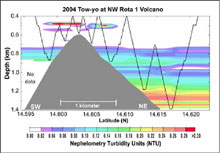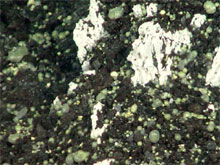
While attempting to sample an outcrop of hydrothermally altered lava, the view changed rapidly (over a 2-min time span) from good visibility (left) to chunks of rock, sulfur and ash totally obscuring the outcrop from our view (right side). The outcrop is ~16 inches high (~40 cm). Click image for larger view.
Brimstone Pit Spits Sulfur Balls at ROPOS!
April 1, 2004
Submarine Ring of Fire 2004 Team
![]() More amazing scenes from the Brimstone pit crater (mp4, 5.5 MB)
More amazing scenes from the Brimstone pit crater (mp4, 5.5 MB)
This has been a very exciting time out here on the R/V Thomas G. Thompson. A few days ago we came across an ![]()
![]() amazing scene of billowing smoke rising from a small crater (mp4, 5.4 MB) on the upper flank of the summit of NW Rota 1 Volcano. Until then we had only found low-temperature clear fluid emanating from the volcanic sand and outcrops of volcanic rock at the top of the volcano. The Brimstone pit crater is located about 100 ft below the summit in rocky terrain. The first site we found (above the pit) was a large area of sand with shimmering water percolating through it. Inserting a temperature probe in it yielded a temperature of over 100 C! A huge amount of heat and highly acidic fluid is coming out of this large area of sand.
amazing scene of billowing smoke rising from a small crater (mp4, 5.4 MB) on the upper flank of the summit of NW Rota 1 Volcano. Until then we had only found low-temperature clear fluid emanating from the volcanic sand and outcrops of volcanic rock at the top of the volcano. The Brimstone pit crater is located about 100 ft below the summit in rocky terrain. The first site we found (above the pit) was a large area of sand with shimmering water percolating through it. Inserting a temperature probe in it yielded a temperature of over 100 C! A huge amount of heat and highly acidic fluid is coming out of this large area of sand.
Further exploration yielded ![]()
![]() the incredible vista of Brimstone Pit (mp4, 5.6 MB). Although the billowing clouds of smoke rising from the pit made it a challenging place to maneuver the ROPOS remotely operated vehicle (ROV), pilot Keith Shepherd was able to slowly move into a position to sample the rising plume. Water samples were taken in the plume, where temperatures of up to 30 C were measured. Our impression is that the pit is funneling up fluid and gas directly from a magma source below. As we sat on the edge of the pit, huge billows of yellow-tinged smoke began enveloping the ROPOS. Yellow balls of sulfur emerged from the cloud and began precipitating on the vehicle. When ROPOS returned to the surface, its front side was coated with small balls of sulfur up to about one-quarter inch in diameter. The droplets had splattered into shapes that left no doubt that the sulfur balls had been in a soft, almost molten form when they emerged from the pit.
the incredible vista of Brimstone Pit (mp4, 5.6 MB). Although the billowing clouds of smoke rising from the pit made it a challenging place to maneuver the ROPOS remotely operated vehicle (ROV), pilot Keith Shepherd was able to slowly move into a position to sample the rising plume. Water samples were taken in the plume, where temperatures of up to 30 C were measured. Our impression is that the pit is funneling up fluid and gas directly from a magma source below. As we sat on the edge of the pit, huge billows of yellow-tinged smoke began enveloping the ROPOS. Yellow balls of sulfur emerged from the cloud and began precipitating on the vehicle. When ROPOS returned to the surface, its front side was coated with small balls of sulfur up to about one-quarter inch in diameter. The droplets had splattered into shapes that left no doubt that the sulfur balls had been in a soft, almost molten form when they emerged from the pit.
Then we began to see something even more amazing. Black chunks of volcanic ash began spewing forth from the pit and hitting the vehicle from the increasingly turbid cloud. Many of these chunks (up to almost an inch in size) were later found wedged into ROPOS. At this point we decided to withdraw from the site, because the acidic water, sulfur, and suspended particles posed a potential danger to ROPOS.
The level of excitement has been high over the past day as we consider the implications of what we have observed. We think that we are observing active volcanic venting for the first time on a submarine volcano. The high levels of sulfur precipitating in the plume attest to the very high levels of gases rising from the magma below.
Other key observations have emerged from the CTD (conductivity, temperature, depth) data taken over and around the volcano. On the descent during the first dive, we dropped into a murky layer unlike anything we had seen before. This set the stage for the astounding story that unfolded over the next few days, as the CTD team of Ed Baker, John Lupton, Ko-ichi Nakamrua and Geoff Lebon made "tow-yos" over the volcano. The layer of cloudy water seen on the first dive turned out to surround the volcano from a depth of 700 m to at least 2,000 m!

This cross-section of NW Rota 1 shows the distribution of particles suspended in the waters around the volcano, as measured by an optical turbidity sensor mounted on a CTD. Click image for larger view and more details
What is happening at NW Rota 1? The observations to date show that the volcano is in an "active phase." Brimstone Pit is spewing gas from a magma source lying directly below, and the volcano, which may be vibrating as magma moves at depth, is releasing a steady supply of sediment from its flank, causing the deep cloudy layer.
There's so much more to be learned here. Is this activity going to persist? For how long? What does the deep turbid layer represent? Is the volcano really shaking off sediment due to magma movement? We can't answer all of these questions with the types of instruments available to us. Perhaps another expedition will investigate these puzzles in the near future. We will be moving north along the arc tomorrow to explore East Diamante volcano, where a different type of hydrothermal signal was detected in 2003.
*The melting point of sulfur is 119 C
Sign up for the Ocean Explorer E-mail Update List.





























